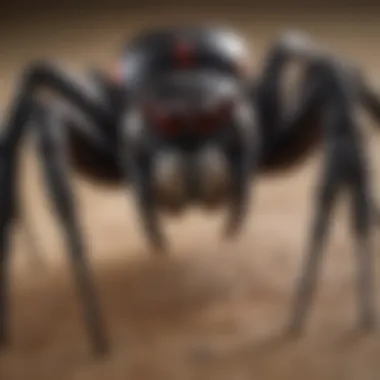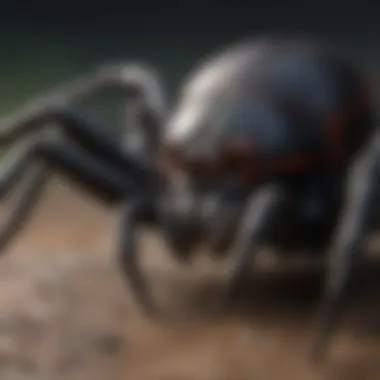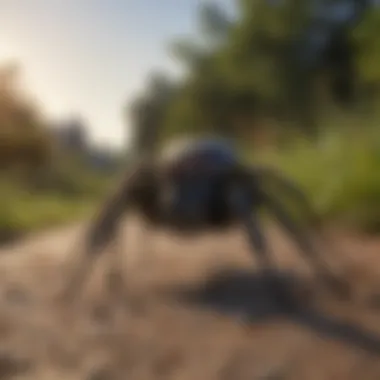Understanding the Black Widow Spider: Identification and Control


Intro
Understanding the black widow spider requires more than just a basic recognition of its appearance. These spiders hold a notorious reputation due to their venom, but comprehending their behavior and control options is essential for effective management. This article gives homeowners the tools needed to mitigate risks associated with the black widow. By focusing on identification, behavior, and control measures, it aims to equip readers for safe pest management.
Understanding Pests
Definition of Pests
Pests are organisms that can cause harm to human interests. This includes damage to crops, property, or health. In the case of the black widow spider, it poses a threat because of its venomous bite. Understanding what defines a pest is pivotal for effective pest management strategies.
Importance of Pest Identification
Identifying a pest correctly is crucial. Misidentification can lead to ineffective or unnecessary treatments. Black widow spiders are small, glossy, and black with a distinctive red hourglass marking on their abdomen. Knowledge of their traits allows for smarter control decisions. Recognizing their habits and habitat preferences also factors into effective management. If one misidentifies the black widow, they may overlook potential danger or risk ineffective control strategies.
Prevention Techniques
Home and Garden Preventative Measures
Preventing black widow spiders from taking residence is essential. Here are some measures that can be implemented:
- Seal Cracks and Gaps: Inspect your home for possible entry points. Seal any cracks in walls and gaps around windows or doors.
- Clear Debris: Keep gardens clean by removing debris and clutter. Spiders often hide in dark places.
- Regular Cleaning: Routine cleaning can eliminate spider webs and deter spider habitation.
Seasonal Prevention Tips
Certain seasons are more conducive to black widow activity. Therefore, adopting specific strategies throughout the year can help:
- Spring: Inspect for nests and webs. Clean up gardens and yards.
- Summer: Monitor for spider activity around outside lights at night.
- Fall: Prepare your home for cooler months by checking for cracks and doing proper sealing.
- Winter: Continue monitoring indoor spaces, as spiders may seek warmth inside.
Eco-Friendly Pest Control Solutions
Overview of Sustainable Practices
Sustainable pest control practices prioritize the environment while effectively managing pests. Using eco-friendly approaches helps preserve beneficial organisms and minimizes chemical use. This can include introducing natural predators or modifying habitats to deter pests.
Natural Remedies and Their Effectiveness
Natural remedies offer viable alternatives to chemical treatments. Some natural options for dealing with black widow spiders include:
- Diatomaceous Earth: Sprinkling food-grade diatomaceous earth in areas where spiders frequent can help dehydrate and eliminate them.
- Essential Oils: Certain essential oils, like peppermint and tea tree oil, can deter spiders when diluted and sprayed in affected areas.
By understanding these methods, homeowners can choose effective strategies for controlling black widow spiders. This promotes safer living environments without risking health or the ecosystem.
Foreword to the Black Widow Spider
The black widow spider is often recognized as one of the most feared arachnids, largely due to its potent venom and unique appearance. Understanding this spider is crucial for homeowners and pest control professionals alike. This section will help demystify the black widow, highlighting key defining features and historical context, ultimately enhancing awareness and safety measures.
Defining the Black Widow
The black widow spider belongs to the genus Latrodectus, known for its shiny black color and a distinctive hourglass marking on the underside of the female's abdomen. Males are smaller and have less noticeable markings. These spiders are often found in dark, secluded areas, making identification challenging for those unfamiliar with their characteristics. They thrive in both rural and urban settings, which increases the likelihood of human encounters.
The black widow's bite can be serious, with varying effects on individuals. It is important to accurately identify this spider to take appropriate action if one is discovered. The presence of the black widow spider should not be underestimated. Knowledge about their habits, habitat, and behaviors plays a vital role in maintaining a safe environment.
Historical Context
Historically, black widow spiders have been a source of fascination and fear. Native to North America, their population has successfully adapted to various environments. Cultural perceptions of these spiders have shifted over time. The black widow's venom gained notoriety in folklore and popular culture, often exaggerated for effect.
In early research, scientists studied these spiders for their behavior and toxins, contributing to a broader understanding of arachnids. Reports of bites were troublesome but rare. Today, enhanced education and advances in pest control methods mean that management strategies are more effective than ever before.
Understanding the history and context of black widow spiders not only aids in identification but also promotes informed pest management strategies.


In essence, this introduction sets the stage for a more in-depth exploration. Subsequent sections will elaborate on identification characteristics, geographical distribution, health risks, and control strategies. With better knowledge, homeowners can feel safer and more confident in managing their environment.
Identification Characteristics
Identifying the black widow spider correctly is crucial for managing risks associated with encounters. This section explores various elements related to the identification of the black widow, highlighting both physical and behavioral traits. Understanding these characteristics aids homeowners in recognizing these spiders before they pose any potential threat.
Physical Appearance
Color Variations
The color variations of the black widow spider are distinct and serve as a primary identifying factor. The females are generally notable for their shiny black bodies, featuring a distinctive red hourglass marking on the abdomen. Males, however, are smaller and exhibit more muted hues like brown or gray, sometimes with white or red markings instead of the hourglass. Recognizing these variations can help in the immediate identification of the spider, providing an effective means to avoid unwanted interactions.
The advantage of being able to distinguish between males and females lies in the fact that females possess venom strong enough to cause health risks. Therefore, identifying color variations not only enhances awareness but also informs safer pest management practices in households.
Size and Body Structure
The black widow spider's size and body structure also play an important role in its identification. Females typically measure about 1.5 inches, while males are noticeably smaller, around 0.5 inches. Their compact and bulbous abdomens contrast against their slender legs, creating a unique profile.
A unique feature of this spider is its hourglass marking, which is prominent in females and less visible in males. This characteristic aids in quick visual identification, allowing individuals to take appropriate preventive measures. Recognizing the size and body structure helps to assess the situation quickly and determine whether intervention is necessary.
Behavioral Traits
Web Construction
The black widow spider's web construction is another critical identifier. Their webs are typically irregular and messy, differing significantly from the symmetrical shapes of other spider webs. These webs serve as traps for insects, demonstrating the spider's hunting strategy.
The web's design is beneficial for catching prey that may come too close, showing that the spider does not rely solely on speed or agility. Understanding these traits allows for better control efforts in homes, as identifying the presence of the web can signal the spider's activity in the area.
Habitat Preferences
Black widow spiders prefer dark, sheltered locations, which often include basements, garden sheds, and woodpiles. Their choice of habitat is essential since it affects human interactions. Knowing where these spiders are likely to reside can help homeowners take proactive measures in protecting their properties.
The advantage of understanding habitat preferences is the ability to minimize the likelihood of an encounter. By regularly inspecting and maintaining these areas, individuals can reduce spider populations effectively. Recognizing the traits of the black widow’s environment can aid in adopting proper prevention strategies.
Geographical Distribution
Understanding the geographical distribution of the black widow spider is critical for both pest control efforts and general awareness. The location of these spiders affects their interaction with humans, other species, and their environments. Recognizing where they are commonly found aids homeowners in taking precautionary measures against potential infestations. It also helps pest control professionals target their efforts effectively.
Native Regions
Black widow spiders are primarily found in various regions of the world, particularly in the United States, Canada, and Mexico. They thrive in warmer climates and are most often located in the southern and western states such as California, Texas, and Florida.
In the U.S., the Latrodectus mactans species, known as the Southern black widow, is prevalent in the southeastern states. In contrast, the Latrodectus hesperus, known as the Western black widow, is found predominantly in the western states, including Arizona and Nevada.
Their habitats typically include:
- Dark and undisturbed areas such as wood piles and sheds
- Rock crevices or beneath debris that provide shelter
- Gardens and outdoor areas where insects are plentiful
These spiders can adapt to a range of locations, making them a common concern for homeowners.
Expansion Patterns
The expansion patterns of black widow spiders highlight their adaptability and resilience. Over the years, their populations have increased in regions previously considered unsuitable for their survival due to changing climate conditions. Warmer temperatures have allowed black widow spiders to establish themselves in northern parts of the U.S. and some areas of Canada.
Factors influencing their expansion include:
- Urbanization, which provides more hiding spots and food sources
- Global warming, which extends their range northward
- Transportation, as hitchhiking on objects or vehicles can introduce them to new environments
Understanding these expansion patterns can lead to better preventative measures for homeowners. Awareness of local populations can help people recognize signs of black widow presence and respond promptly.
"Knowledge of black widow spider distribution empowers homeowners to take proactive steps in pest management, enhancing safety and comfort within their living spaces."


In summary, the geographical distribution of the black widow spider provides vital information for managing these pests effectively. Learning about their native regions and how their populations expand can help individuals make informed decisions about their properties.
Venom and Health Risks
The discussion of venom and health risks is crucial when considering the black widow spider. Understanding its venom composition and the possible health implications of bites can inform better decision-making for pest management. Knowledge about these risks can also alleviate fears and misconceptions.
Understanding Spider Venom
The venom of the black widow spider is primarily composed of neurotoxins. This means that it targets the nervous system. Once injected through a bite, the venom can interfere with normal nerve function, leading to a range of symptoms. One of the significant concerns is how quickly this venom can affect the body, emphasizing the necessity of immediate medical attention.
It's also important to realize that not every bite results in the same level of severity. Factors such as the amount of venom injected, the size and health of the victim, and pre-existing health conditions can all play a role. Each of these elements contributes significantly to the overall discussion surrounding the necessity for knowledge and caution.
Symptoms of Bites
Immediate Reactions
The immediate reactions to a black widow spider bite can be quite alarming. Many individuals report a sharp pain at the bite site, often described as a pinprick followed by swelling and redness. This prompt response is critical for identifying the bite and seeking treatment quickly.
The key characteristic here is that the symptoms can escalate within a short period, typically within a few hours. This urgency underscores the importance of recognizing the bite early. Although some might consider this reaction as merely discomfort, it's essential to remember that it serves as a signal for medical intervention. The unique nature of these immediate effects warrants attention since they can lead to further complications if not addressed in time.
"Timely response to a spider bite can be the difference between a minor health issue and a serious medical condition."
Long-term Effects
Long-term effects of a black widow bite can vary significantly. In some cases, individuals may experience chronic pain, muscle spasms, or emotional distress following a bite. Understanding these potential consequences is essential not only for personal health but also for conveying accurate information to others, as fear often stems from misinformation.
The key aspect of long-term effects is awareness. Recognizing that some symptoms can linger after initial treatment can encourage consistent follow-up care. This insight is valuable in fostering a comprehensive approach to health post-exposure. The unique features of these long-term symptoms can influence future behavior regarding spider interaction and awareness. While they may not be common, the possibility of lasting health issues reinforces the importance of education and precaution.
The consideration of both immediate reactions and long-term effects enriches the discussion surrounding the black widow spider. This multifaceted knowledge helps individuals recognize the potential risks involved, thereby promoting safer practices and informed responses.
Control Strategies
Understanding effective control strategies is fundamental in managing black widow spider populations. These strategies are designed to minimize spider infestations and lower the risks associated with their venomous bites. Employing a multifaceted approach can lead to successful outcomes in spider management. Control measures can be broken down into preventive actions, chemical methods, and non-chemical alternatives, each playing a crucial role.
Preventive Measures
Reducing Attractiveness of Property
One key aspect of reducing the attractiveness of property involves making the environment less appealing for black widow spiders. This includes actions like removing debris such as leaves and wood piles, which provide shelter. Keeping the lawn well-trimmed and ensuring that shrubs do not touch the house also helps. Reducing attractiveness is popular because it not only minimizes spider presence but also counters other pests. The unique feature lies in its focus on environmental modifications that yield long-term benefits. However, homeowners must remain diligent since these measures require ongoing effort.
Regular Inspections
Regular inspections allow homeowners to identify early signs of black widow presence. This practice involves examining hidden areas, such as basements and garages, where spiders might reside. The key characteristic of regular inspections is vigilance. It acts as a preventive measure by offering insight into potential infestations before they escalate. This method is practical because it enables individuals to address issues proactively. However, some may neglect inspections, which can lead to larger problems if spiders establish nests.
Chemical Control Methods
Types of Insecticides
Types of insecticides vary widely, but some are specifically geared toward black widow control. Common options include pyrethroids, which are effective in killing spiders on contact. The major benefit of these chemicals is their immediate impact, significantly reducing spider populations. However, it is crucial to follow guidelines and choose insecticides labeled for spider control. While effective, there are ecological considerations. Chemical resistance can also develop if used repeatedly without rotation.
Application Techniques
Application techniques are vital for ensuring that insecticides reach the intended areas. Techniques include spraying and granule distribution, with localized application around potential spider habitats. The power of application techniques lies in the precision they offer, facilitating effective targeting of nests and webs. Proper application can drastically improve results. The disadvantage is that improper application may lead to insufficient control or even harm to non-target species.
Non-Chemical Control Methods
Traps and Baits
Traps and baits are valuable methods for controlling black widow populations without chemicals. Sticky traps can be placed around areas where spider activity is noted. The benefit of this approach lies in its safety for human use and the ability to monitor spider populations effectively. However, traps must be regularly checked and replaced, as they can become less effective over time. The need for consistent monitoring may deter some homeowners from using this method.
Natural Predators


Incorporating natural predators is another non-chemical strategy. Some insects and birds, like wasps and certain lizard species, prey on black widow spiders. This approach helps maintain a balance in the ecosystem. One of the main advantages is that it minimizes reliance on chemical solutions, promoting a healthier environment. However, natural predation may take time to establish, and it requires an understanding of local ecological dynamics.
Effective management of black widow spiders often requires a combination of strategies tailored to individual situations.
By synthesizing these control methods, homeowners can take informed steps towards managing black widow spiders sustainably.
Ecological Importance
The ecological significance of the black widow spider extends beyond its notorious reputation. This section explores why understanding its role in the environment is essential. The black widow contributes to ecological balance, serving various functions in ecosystems that may not be immediately apparent.
Role in Ecosystems
Black widow spiders play a vital part in local ecosystems. They are natural predators, effectively managing populations of insects. This pest control is beneficial for maintaining a healthy balance in nature. Without these spiders, certain insects might proliferate, potentially disrupting plant life and other animal species.
Their web-building behavior also aids in the capture of flying and crawling insects, creating a dynamic food web. In this sense, black widows are not merely a threat to human safety; they fulfill a necessary role in their habitats by controlling prey populations and fostering biodiversity.
Food Web Dynamics
The black widow is integrated into complex food webs. As a predator, it serves as a food source for various larger animals such as birds and other predators. Without the presence of black widows, these larger species may struggle for food, thus impacting their populations. The absence of this spider may lead to a rise in the number of insects, which can harm crops and affect agricultural practices.
"In nature, each species has its place, and removing one can cause unforeseen repercussions."
Understanding the food web dynamics is critical. It helps in appreciating the delicate balance of ecosystems. Homeowners and pest control professionals should be aware that while black widow spiders can pose risks, their ecological roles are significant. Effective pest management should consider their impact on the environment, promoting coexistence rather than extermination without cause.
In summary, while the black widow is often regarded solely as a venomous spider, its broader ecological importance cannot be ignored. Recognizing its role in food webs and ecosystems encourages a more nuanced approach to spider management.
Common Misconceptions
Understanding the black widow spider is clouded by several misconceptions that can influence how people respond to their presence. These misunderstandings can lead to fear or neglect in dealing with this spider species. Addressing these misconceptions is crucial for effective management and education. It is essential to distinguish between facts and myths regarding the black widow. This section provides clarity by demystifying common false beliefs surrounding these spiders, helping homeowners make informed decisions regarding pest control.
Overestimation of Danger
One prevalent misconception is that the black widow spider poses an extreme threat to human life. While it is true that its venom is potent, fatalities from bites are quite rare. In fact, most people who are bitten experience symptoms that are unpleasant but not life-threatening. The belief that all black widow encounters lead to dire consequences is exaggerated.
There are measures that people can take to minimize risk. Being educated about these spiders and their habitats can significantly reduce unwanted encounters. It is important to understand that black widows prefer secluded and dark areas. Therefore, places like garages, sheds, and attics are typical habitats.
"Overestimating the danger can lead to unnecessary anxiety and aggressive measures that could harm the environment."
People should focus on prevention rather than panic. If a black widow is spotted, that does not mean immediate danger. Rather, it offers an opportunity for appropriate action, such as calling pest control experts for safe removal.
Effectiveness of Common Remedies
Another common belief is that household remedies can effectively deal with black widows. Many might suggest using essential oils or vinegar as deterrents. While these may have some short-term effects, they are not proven methods for long-term control. The black widow spider is remarkably resilient.
Households often resort to home remedies, which can be tempting due to their perceived safety. However, relying on these methods can create a false sense of security. Rather than addressing the problem efficiently, such tactics could exacerbate the issue.
For effective spider control, homeowners should consider scientifically-backed methods. Chemical treatments and traps specifically designed for venomous spiders offer more reliable results.
In summary, understanding the black widow's real dangers and the limitations of home remedies is vital for effective management. Knowledge can empower homeowners to take appropriate steps without resorting to misconceptions.
Culmination
Summary of Key Points
This article has explored various aspects of the black widow spider:
- Identification: Understanding physical and behavioral characteristics helps in recognizing the species. It also eliminates confusion with similar spiders.
- Venom and Health Risks: Knowledge about the spider's venom is crucial. Recognizing symptoms of bites ensures quick action in case of encounters.
- Control Strategies: Effective management combines chemical and non-chemical methods. Preventive measures are key in reducing spider populations around homes.
- Ecological Importance: Recognizing the role of black widow spiders within ecosystems helps appreciate their existence. They contribute to pest control by preying on insects.
- Common Misconceptions: Addressing myths surrounding the black widow can reduce unnecessary fear and promote safe practices.
This comprehensive summary serves as a handy reference for readers when they engage in pest management discussions.
Final Thoughts on Management
The management of black widow spiders should be approached with an informed mindset. Homeowners can take practical steps to prevent infestations. Simple actions like keeping areas tidy and sealing entry points are effective. Regular inspections are also recommended to detect early signs of their presence.
For more serious infestations, consulting pest control professionals is advisable. They can provide targeted treatments, ensuring safety for both the inhabitants and the environment. The balance between efficacy and ecological considerations should always be maintained.
"An informed homeowner is the first line of defense against black widow spiders. Utilizing the right strategies can make a significant difference in making homes safer."



